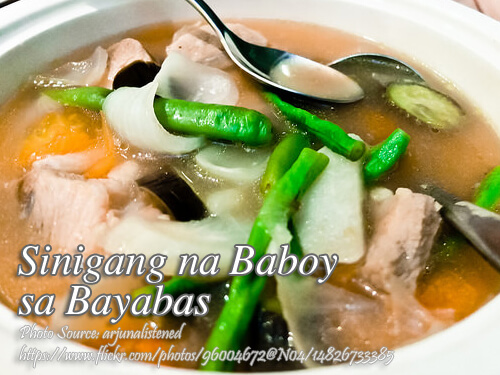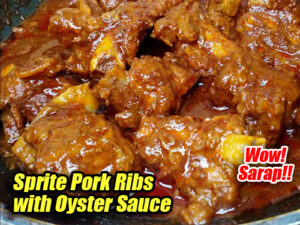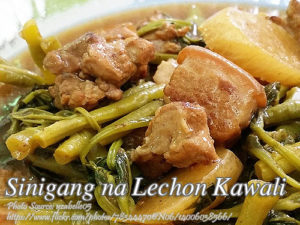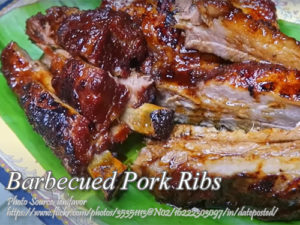This pork ribs sinigang is a variation of the original pork sinigang dish that uses tamarind as a souring agent for the broth. Guava is a good alternative to tamarind to make your broth sour and it is also a good source of vitamin c too. In case you don’t like to use pork ribs, you can use pork shoulder or pork belly which is suited for cooking sinigang and easier to tenderize.
There is comfort in nothing compared to that warm bowl of sinigang, especially on a rain-soaked afternoon. For one who spent most of one’s childhood in the province, sinigang was always waiting for us at home when the skies became gray and the breeze just a little bit cool. My Tito Lando, who lives in Batangas, actually had a unique version of sinigang made with guava instead of the traditional tamarind. Sinigang na Baboy sa Bayabas is that variation which carries a sweeter and more mellow sourness that is both refreshing and soothing.
I remember the first time this recipe was tried in his home; it was as if to be transported to a place of pure nostalgia with the smell of guava, fresh pork, and fresh vegetables filling the house. Unlike the pungent sourness of tamarind, the guava has added a soft, delicate fruit flavor to the broth, again perfectly balanced between sweet and sour. For my Ate Mila who is more of a sinigang doused in traditional tamarind flavor, this version had her asking for seconds!
A Variation of an Iconic Filipino Dish
One of the favorite soups in the Philippines, sinigang is one of those dishes that needs to be tried for any food enthusiast who dares into the culinary sea of the Philippines. Traditionally prepared with pork, shrimp, and/or beef, tamarind was the common souring agent used in the broth. However, people from certain regions have come up with their own different souring agents such as calamansi, kamias, or guava. Guava here does not only add to the flavor but also as a nod to the very liberality with which the tropical fruits we enjoy in the Philippines are lavished. My Lola Ester used to say that whenever the guava trees were in season, this dish would always be on our menu.
The natural sweetness of the guava does much to complement the richness of the pork, which still holds to that unmistakable tanginess which sinigang is famous for. And if you’re looking for a way to get more vitamin C into your diet, guava is a fantastic source, making this dish not only delicious but nutritious as well.
Choosing the Perfect Cut of Pork
When preparing this dish, it’s important to choose the right cut of pork. We often use pork ribs at home to add deep, meaty flavor, but if you’re looking for something more delicate or softer to chew on, pork belly or pork shoulder works out great. The trick, of course, is to braise the meat until it’s meltingly tender. My Tita Vicky would always remind me to be more patient when cooking this dish. “Hindi pwedeng minamadali ang sinigang,” she’d say with a smile. “The secret is in the slow simmering, letting all the flavors of the pork, guava, and vegetables melt well together.”
After adding the pork to the boiling water, the guava is also added. This makes the broth infused with a different flavor. The pork and guava flavor makes the broth more substantial and thicker than other sinigang versions, which explains why it is even more comforting.
The Must-Have Vegetables
Of course, such sinigang dishes would never be complete without a rich serving of vegetables. As a child, I used to help my Nanay pick fresh produce from the backyard for our sinigang, and she was really particular in ensuring that gabi (taro), sitaw (long beans), okra, and eggplant were prepared and readied. These vegetables add flavor and texture to the dish. For instance, the sitaw and eggplant absorb the broth and, in the mouthful, give that perfect delighting bursts of flavor; the gabies, on the other hand, thicken up the broth and give it a velvety texture.
Yet another key ingredient of this dish is kangkong, or water spinach. Kangkong is added at the very end of the cooking process. I can remember my dear Kuya Ramon saying to me, “Do not overcook the kangkong, or it’ll lose its bright color and crunch.” This therefore means that add it at the very last minute so that its fresh green hue and slight crispiness will remain – a perfect contrast in this dish against the richness of the broth.
A Dish Full of Flavor and History
While it’s merely a dish, sinigang in whatever form is more than that; it’s reflection on life, Filipino-style. Simple yet profound in flavor, that’s like us – earthy and vibrant. This guava version finds its roots in the rural backwaters where guavas grow aplenty, and families get to utilize whatever is available to their advantage. It reminds me that this dish represents the Filipino aspect of being resourceful, building something delicious from simple ingredients.
My Lola Ester would say to me that sinigang is for people. It is supposed to be shared between family members who enjoy each other’s company. And, like that, every time we gather around the table with a steaming bowl of guava-infused sinigang, the warmth and sense of belonging seem to fill the air.
How To Cook For First-Timers
If you are a first-time cook of this recipe, don’t be intimidated by the long process of cooking. Sinigang is one of those dishes that rewards patience. The pork has to become tender, and this means giving it time. The longer you let it cook, the deeper the flavors of the guava will penetrate the broth. Of course, the seasoning must be adjusted along the way and the vegetables used must be up to your creativity.
As what my Tita Vicky used to say, “There’s no one right way to make sinigang.” Every family, every household, has its own way of preparing this dish so please, feel free to make it your own. And when in doubt, just remind yourself that the key to a good sinigang is love. Love for your ingredients, love for your process, and most of all, love for those whom you cook for.
So the next time you are craving a soothing, delicious bowl of sinigang, try this delightful, guava-infused variation. It is simply an exquisite twist on the classic: it’s sure to warm the soul and your table.
How to Cook Sinigang na Baboy sa Bayabas
Ingredients
- 1 kilo pork ribs chopped to serving pieces
- 2 pcs small eggplants slice diagonally
- 1 bunch kangkong remove from the stem
- 2 pcs tomatoes quartered
- 1 inch ginger slice into strips
- 1 Tbsp. patis or fish sauce
- 5 pcs okra sliced
- 2 cups sitaw or string beans sliced 1 1/2 inch
- 3 pcs small gabi or taro root peeled and quartered
- 3 pcs siling labuyo or bird's eye chili peppers
- 2 pcs small red onions sliced
- 1/2 kilo guavas quartered
- salt and pepper
Instructions
How to cook Sinigang na Baboy sa Bayabas:
- In a medium size stainless steel pot, boil some water slightly more than enough to cover the meat.
- While the water is boiling, put the pork ribs one by one until every piece of meat is in the pot.
- Then add the tomatoes and guavas and cook for about 30 to 40 minutes or until the meat is tender.
- Add the onions, gabi, siling labuyo, ginger, salt and pepper then cook for another 8 minutes.
- Then add the sitaw, okra and eggplants and simmer for another 6 minutes. Add in the kangkong and simmer for 1 minutes more. Serve hot.
Notes
Cooking Tips:
Choose the Right Guava for the Broth
For your sinigang, you can use guavas that are ripened but firm, balancing the sweetness with the tang in the broth. Overripe guavas turn mushy and overpower the flavor. Under-ripened ones would not give you that sweetness. Slice them thick enough that they can hold their shape while simmering.Pork Toughened to Perfection
Simmer the meat with low to medium heat for at least 30 to 40 minutes to achieve a tender pork that falls apart in your mouth. Letting the pork boil too aggressively could toughen it rather than making it tender. Patience reaps the best reward from letting the broth and the meat cook together.Add Vegetables at the Right Time
Different vegetables have different cooking times. Add the gabi first; the siling labuyo should also go in early, so it infuses into the broth completely, and then add kangkong later, so it is fresh and crunchy. You will never overcook your vegetables this way.Nutrition Notes:
Calorie and other nutrition information is derived from HappyFolks.Com recipe nutrition calculator. The percent daily value (%DV) is based on a daily 2,000 calorie diet.Nutrition Facts:
Amount per Serving:556g, Calories: 494kcal, From fat:149, Total fat:16.6g, Saturated Fat:5.2g, Trans Fat:0.1g, Cholesterol:111mg, Sodium:566mg Total Carbohydrate: 37g, Dietary Fiber: 12g, Sugars: 14g, Protein: 51g, Vitamin A: 135%, Vitamin C: 406%, Calcium: 17%, Iron: 23%






Love your sinigang sa bayabas recipe! Guava is my favorite fruit !
Hi Jane, glad you found this recipe! Cheers!